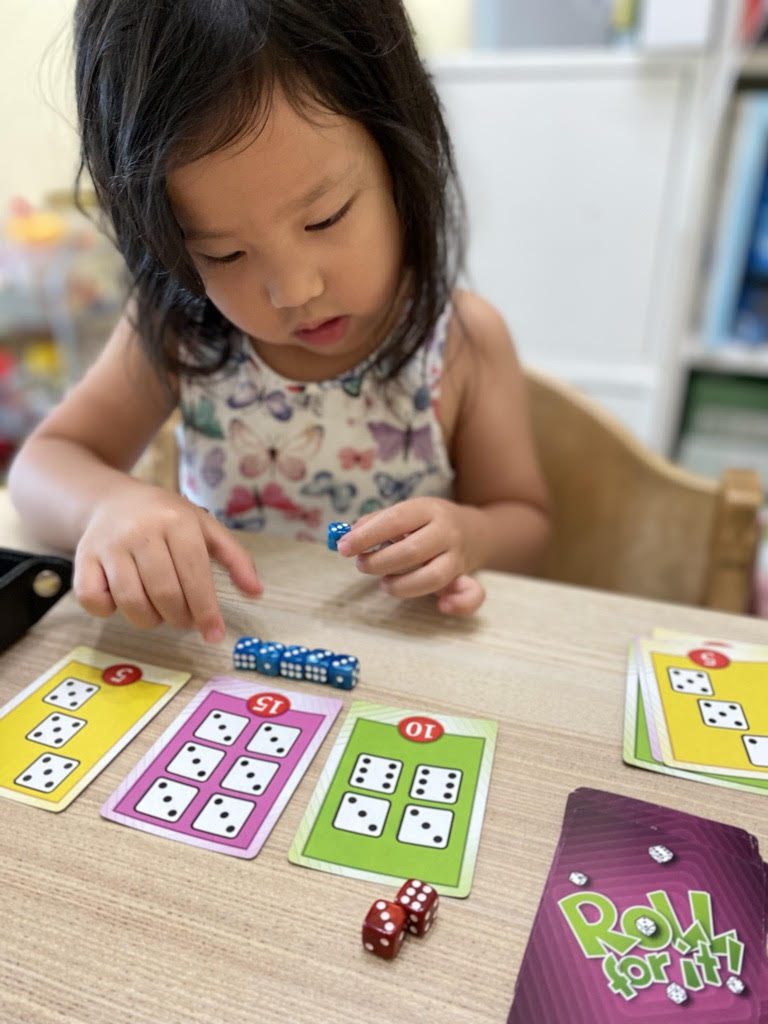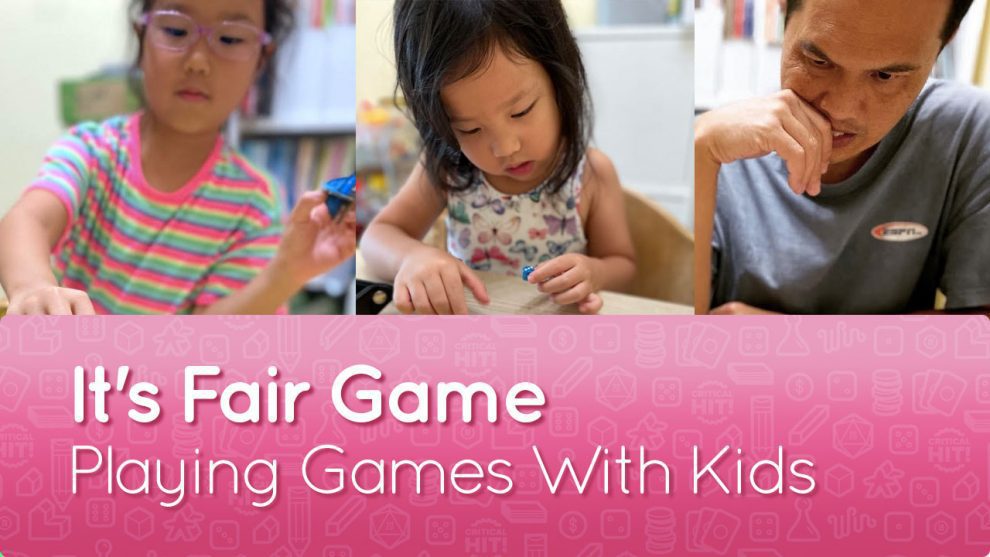Come 7 o’clock every night, without fail, we turn our dining table into a tabletop gaming experience for our family. We all look forward to it; from the 5 year old to the 50 year old. And, if you thought we played kiddy games to keep our 5 and 7 year old appeased, you would be wrong. Our children play family weight tabletop games like Wordspiel, Station Master, Azul, Catan, Photosynthesis and Ticket to Ride.

We don’t pair up with the littles and we certainly do not let them win. They do, in fact, bring their game to the table and beat the adults regularly but, thankfully, not all the time. Yet when they lose there are no tears, pounding of feet or pouting of lips because they’ve still had fun. Here are six ways we play with our little meeples that have been transformative in helping them enjoy the ups and downs of competitive tabletop gaming.
Individual attention
When it is family time, we do not want to spend precious time explaining the rules, demonstrating and then having kids experiment through trial and error. If we did that the young players are going to get bored waiting. And if that happened, the adults would have to keep the kids entertained. And, by the time everyone is on the same page to play, it is time to go to bed.
Instead, as part of the one-to-one time I spend with my kids, we dedicate a portion of it to individualized attention teaching them new games, rules, strategies, and playthroughs together to work through the kinks and teach them new moves and strategies. It’s hardly as structured as it sounds; more a case of “Hey, want to play this new game? I think you’d like it. Then we can play it together with the rest of the family.” We play a few rounds this way so that they’ll be ready with tried and tested strategies that we’ve gone through during practice that they can pull out when competition gets tough!
Offer Choices
After we’ve explained how to play a game, I give suggestions of moves they can make in order to win big in initial practice rounds, and explain why those work. That way they will get an idea of what the basic strategy might look like. After that, it’s hands off. Instead, I point out situations they ought to look into and try to offer them two to three really good choices whenever possible so that kids get an opportunity to experiment moves for themselves.
It is hard work not to jump in and direct their play. As an experienced adult, you want them to feel good and you know how to win a game. And we tend to put the two together. The long game (pun intended) is for kids to learn from their choices, to own their successes and mistakes, and to figure out how to solve their own problems. The more practice they get in doing so independently, making those choices and reaping those results, the better they get at making informed decisions. And the best part is that the experience of problem solving transfers into reality. As for the adults, when you’re giving them good choices they can choose to play, it feels like you’re playing against another version of yourself since the kids choose the final decisions between the options you’ve presented.

Be an open book
So, what do you do when they choose differently from you? After a few prompts, I’ve found that the best way to teach is to model the appropriate mindset and perspective. For example, instead of playing with a closed hand of cards, I often lay them open at the table and talk through how I view the gameplay. Then I think aloud my hypotheses of how things are going to pan out if I made one move or another. Once you have talked through and made a few winning moves, their ears will start to perk up and want to mimic those moves you’ve been showing them, rather than telling them to do. Then they will feel empowered as if they have made those decisions for themselves!
Focus on the small wins
Which brings us to the small wins. Waiting till the end of the game when someone has won or lost is too late for a debrief. When the final gauntlet is down, emotions may be too high for young players to hear what you have to say then. Instead, talk about all the incremental successes as it happens; when someone’s made a strategic move to block an opponent, when they have waited for an opportune time to cash in on a move, or mistakes you have made that have then opened up possibilities for them as your opponent to defeat you.
Instead of winning or losing the game being the sole arbiter of success, we can celebrate the decisions they made, from those choices that you may have provided along the way, strategies they have picked up that have led to small accomplishments in the game. Ask them about their plan and strategy when they have made a decisive action. Recall their good moves in casual conversation after the game regardless of who has won. “Why did you move that piece? That’s a good move. You’re blocking me there!” The positive reinforcement as it happens also helps them enjoy the gameplay even if they lose at the end.

Playing with a handicap
In golf, players get a handicap which is an extra number of strokes so that the competition is fair. The same can be done in most tabletop games. The idea is to enable players of varying abilities to compete equitably. Younger and less experienced players are given some advantage in ways that do not undermine the game. In reverse, apply challenges for more experienced players so competition is more level. For example, when playing word games such as Wordspiel, Bananagrams or Scrabble, we play so that adults have a time limit of 1 minute but the kids do not, since the adults have much deeper reserves of vocabulary by nature of being older. Or, when trading in Catan, child-players have a set exchange of 2:1 with the bank or other players regardless of supply whereas adult players will have to negotiate between opponents or whatever is set forth in the game.
Pared down complexity
Lastly we like to pare down the game to its most basic gameplay, start there and slowly build up complexity. Once we determine the objective of the game, we distill the specific actions that lead to a victory. Here’s how we introduced Mystic Market to our five year old. Since the winner is determined by who has the most money at the end of the game, we focused first on the actions that earn the most coins. That is, sell complete sets of the same potion. Once they were comfortable with that basic action of purchase-collect-sell then we introduced small parts of the game mechanism that add depth. In this case, selling a single potion to create a supply imbalance, causes the other commodities to fluctuate so that she could manipulate the market in her favor. Further along we then added the Supply Shift cards to layer complexity and then finally the Potion cards. Played this way, we did not wait till they are ten as the box says, to teach it all at a go. Instead we can start as early as five with each simple action, to teach them economics of demand and supply, of simple commodities speculation all while building a foundation slowly from simply set collecting.
Trying any one of these suggestions—even on their own—can change the way your family plays games with the little ones. Try them one at a time and build up your kids’ gaming instincts and be prepared that they will soon beat you fair and square at your own game!











I’m not familiar with board games. I didn’t growing up playing them and I do not know a single game you mentioned but I surely admire the way you empowered your children to play. I wish I have more time to learn some games and play them too! I’m amazed how much children can comprehend and strategize! My 5 year old picked up chess a few months ago and now he would not stop bugging us to play!
Thanks for the article! I think it’s pretty amazing that you’re actually able to game with your kids without constantly explaining, throwing the game or having to deal with massive meltdowns afterwards!
Thanks for the helpful tips. We like to play card games in our family, especially with the grandparents. It’s a great activity to easily involve all ages across multiple generations.
This is an excellent article! I really like the part where you talk about focusing on small wins.
I’m having trouble playing chess with my 5-year-old since I find it *really* hard not to make the best moves I could make. Beyond just wanting to win (naturally), I think part of my struggle is that it feels downright dishonest to intentionally make bad moves, as if I’m modeling something false to him. After reading your article, I got the idea to let him handicap me by choosing some of my pieces to be removed from the board before the game starts. Then he and I can each play our very best but still each have a chance of winning. We’ll see how it goes!
Above and beyond your helpful ideas, I also simply enjoyed the read since your passion for gaming imbues every sentence. Thanks!
Martha, removing some pieces pre-game is a great idea. We have another article about playing games with younger kids that offers similar alternatives.